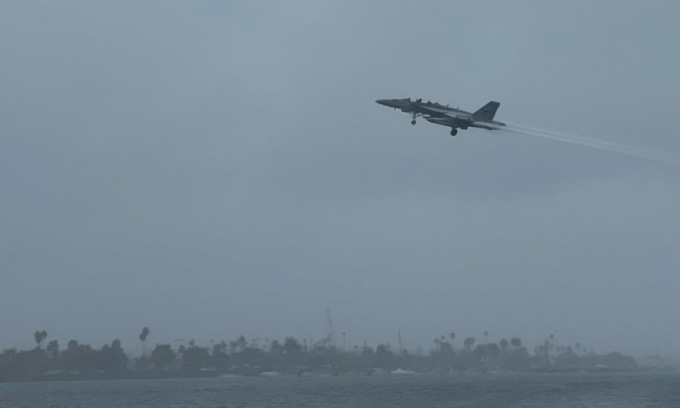Aviation experts in the U.S. have described the crash of an EA-18G Growler electronic warfare jet as "bizarre", raising questions about pilot training and operational readiness.
The EA-18G Growler, assigned to the U.S. Navy’s Electronic Attack Squadron 135 (VAQ-135), crashed into San Diego Bay, California, on February 12. Both pilots ejected safely and survived without major injuries.
Shocking Crash Caught on Camera
Security camera footage captured the jet plunging nose-first into the water at high speed, with its landing gear already deployed. The canopy was seen detaching mid-air as the crew ejected.
More than three days after the crash, authorities have yet to recover the wreckage, and the Navy has not publicly shared any preliminary findings. A spokesperson stated that the incident occurred during a wave-off maneuver, where the aircraft was forced to abort landing and gain altitude. At the time of the crash, the area was experiencing rain and dense fog.
Aviation Experts Question the Incident
Many aviation experts and former military pilots have expressed shock, as the EA-18G Growler is a highly advanced jet designed to operate in far more challenging conditions.
Dr. Rex Rivolo, a former Pentagon analyst who evaluated the F/A-18 series from 1992 to 2009, called the event “absurd” and difficult to comprehend.
“It’s almost unbelievable that a fighter jet—operating in peacetime, not in combat, and facing no known threats—could crash like this. The Growler is an extremely reliable aircraft, and major technical failures are rare,” Rivolo told The War Zone.
The EA-18G is an electronic warfare variant of the F/A-18F Super Hornet, with a unit cost of approximately $70 million. It features cutting-edge sensors and jamming equipment designed to detect and neutralize enemy air defense systems.
Possible Causes: Pilot Maneuver or System Failure?
Ron Alvarado, a former U.S. Marine Corps pilot, suggested that the aircraft may have lost lift while turning left, causing it to spiral down.
“It appears the Growler continued on the last control input given by the pilots before they ejected. It’s possible they deliberately steered the jet away from populated areas to prevent ground casualties,” he speculated.
Jim Kidrick, a former U.S. Navy fighter pilot and current director of the San Diego Air & Space Museum, believes the investigation must focus on the crew’s training and combat readiness.
“The key question is whether the pilots were adequately trained for their mission and the specific weather conditions they encountered. This directly relates to their proficiency and operational readiness,” Kidrick explained. “What matters most is that both pilots survived and will likely return to duty.”
Second EA-18G Growler Crash in Three Months
The San Diego crash marks the second major EA-18G Growler incident in less than three months. In November 2023, a Growler from Electronic Attack Squadron 130 (VAQ-130) crashed into a mountain in Washington state, killing both pilots.
Investigators will now determine whether systemic issues—ranging from pilot training to aircraft maintenance—may have contributed to these back-to-back crashes involving one of the Navy’s most sophisticated jets.
(Sources: Eurasian Times, The War Zone, AP)



